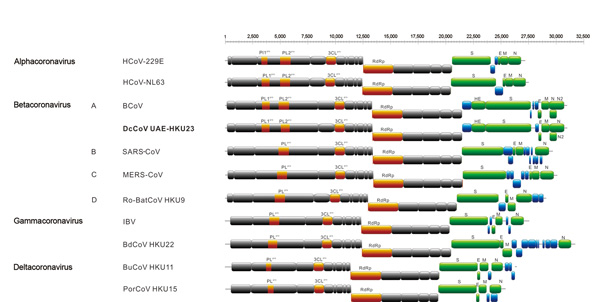Volume 20, Number 4—April 2014
Research
Novel Betacoronavirus in Dromedaries of the Middle East, 2013
Figure 1

Figure 1. . . . . . Genome organizations of a novel betacoronavirus, in boldface, discovered in dromedaries in the Middle East in 2013, and representative coronaviruses from each coronavirus genus (labeled on left). Numbers at top represent genome position. A, B, C, and D represent betacoronavirus lineages. Papain-like proteases (PL1pro, PL2pro, and PLpro), chymotrypsin-like protease (3CLpro), and RNA-dependent RNA polymerase (RdRp) are represented by orange boxes. Hemagglutinin esterase (HE), spike (S), envelope (E), membrane (M), and nucleocapsid (N) proteins are represented by green boxes. Putative accessory proteins are represented by blue boxes. HCoV, human coronavirus; BCoV, bovine CoV; DcCoV, dromedary camel CoV; SARS-CoV, severe acute respiratory syndrome CoV; MERS-CoV, Middle East respiratory syndrome CoV; Ro-BatCoV, rousettus bat CoV; IBV, infectious bronchitis virus; BdCoV, bottlenose dolphin CoV; BuCoV, bulbul CoV; PorCoV, porcine CoV.
1These authors contributed equally to this article.